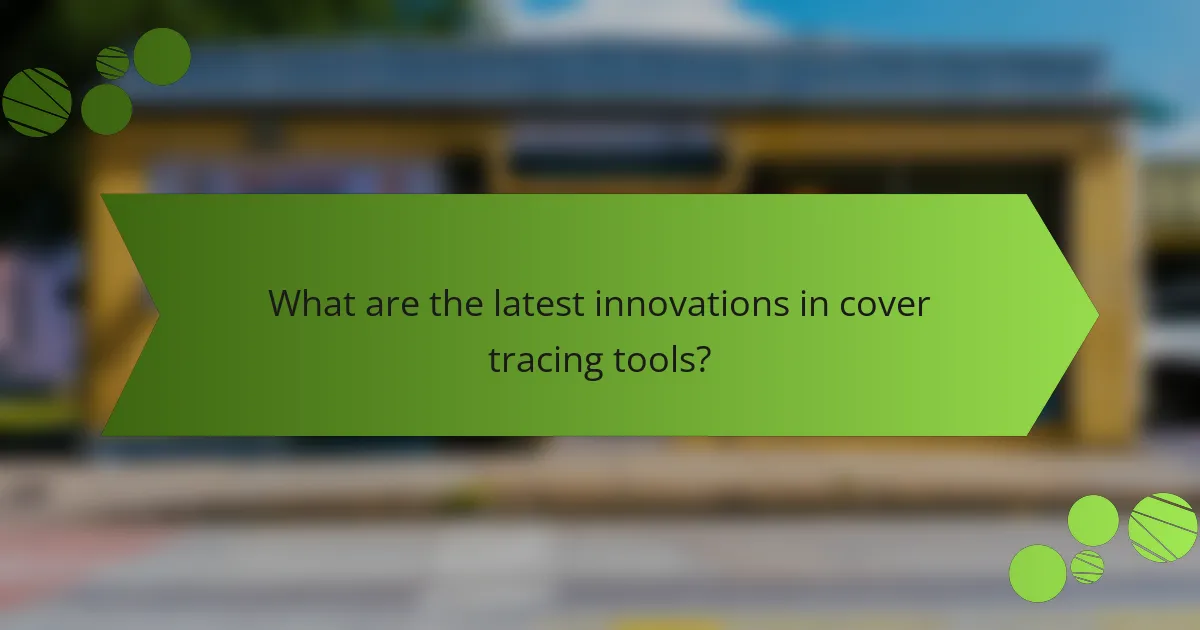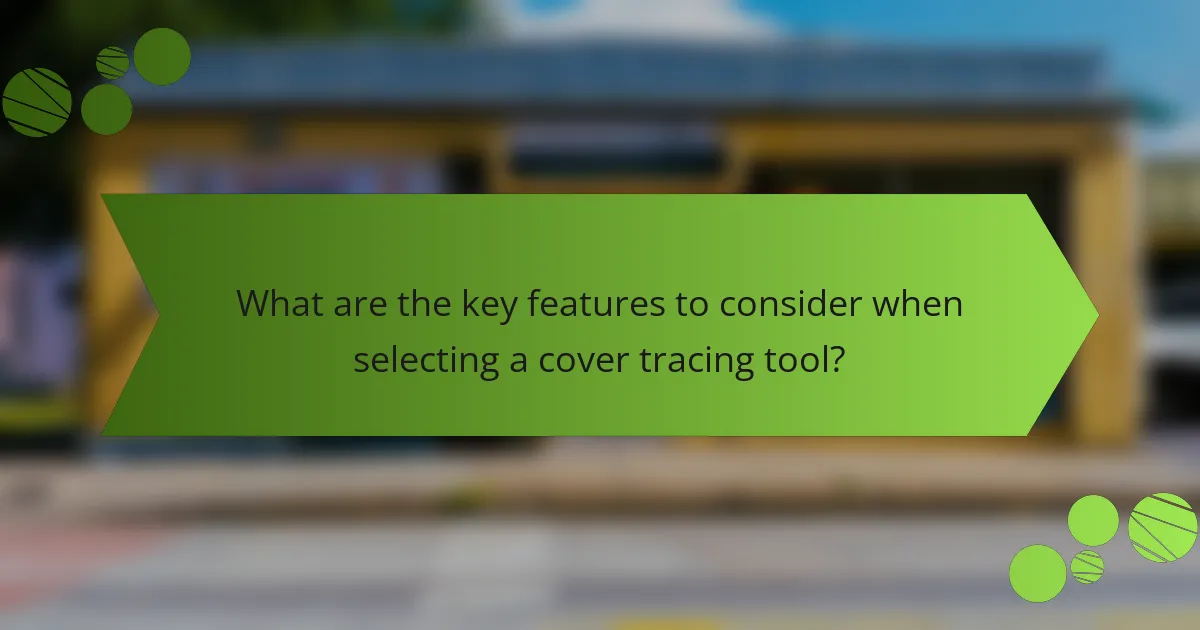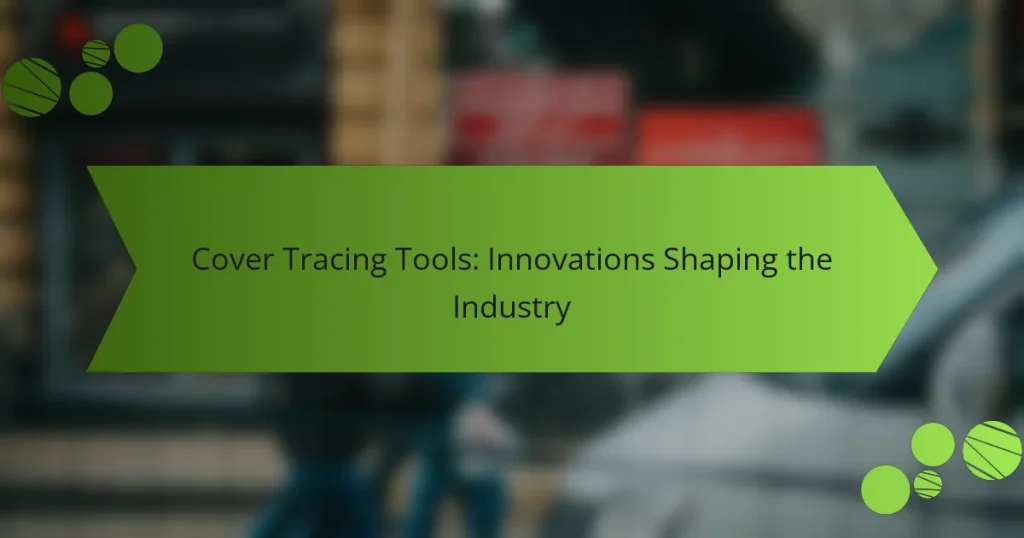Innovations in cover tracing tools are revolutionizing the industry by improving accuracy, efficiency, and collaboration among professionals. With advancements such as AI-driven algorithms and cloud-based features, these tools streamline the tracing process, automate repetitive tasks, and enhance workflow efficiency, ultimately leading to quicker project turnaround and better data handling.

What are the latest innovations in cover tracing tools?
The latest innovations in cover tracing tools focus on enhancing accuracy, efficiency, and collaboration. Key advancements include AI-driven algorithms, cloud-based features, and real-time analytics that streamline the tracing process for professionals in various industries.
AI-driven tracing algorithms
AI-driven tracing algorithms significantly improve the precision of cover tracing by utilizing machine learning techniques to analyze patterns and predict outcomes. These algorithms can adapt to various datasets, making them versatile for different applications, from construction to manufacturing.
For example, an AI algorithm might analyze historical data to identify the most efficient tracing paths, reducing time and material waste. Companies adopting these tools can expect increased accuracy and reduced human error in their tracing processes.
Cloud-based collaboration features
Cloud-based collaboration features enable multiple users to access and work on cover tracing projects simultaneously, regardless of their location. This innovation fosters teamwork and enhances communication among stakeholders, making it easier to share updates and revisions in real time.
Tools that incorporate cloud features often allow for version control, ensuring that all team members are working with the latest information. This can lead to faster project completion and improved overall efficiency.
Real-time data analytics
Real-time data analytics provide immediate insights into the tracing process, allowing users to make informed decisions on the fly. This capability helps identify potential issues before they escalate, enabling proactive adjustments to workflows.
For instance, a tracing tool with real-time analytics might alert users to deviations from expected patterns, prompting them to investigate and correct the issue promptly. This responsiveness can save time and resources throughout a project.
Integration with CAD software
Integration with CAD software streamlines the workflow for professionals who rely on design and engineering tools. By connecting cover tracing tools with CAD applications, users can easily transfer data and maintain consistency across platforms.
This integration allows for seamless updates and modifications, ensuring that any changes made in the CAD environment are reflected in the tracing tool. As a result, users can maintain accuracy and efficiency throughout the design and tracing phases.
Mobile application advancements
Mobile application advancements have made cover tracing tools more accessible, allowing users to perform tasks on-the-go. These applications often feature user-friendly interfaces and essential functionalities that enable quick tracing and data entry from smartphones or tablets.
For example, a mobile app might allow field workers to capture measurements and upload them directly to the tracing system, reducing delays associated with data transfer. This flexibility enhances productivity and ensures that teams can stay connected and informed, regardless of their location.

How do cover tracing tools improve workflow efficiency?
Cover tracing tools enhance workflow efficiency by automating repetitive tasks, reducing manual errors, and facilitating better collaboration among team members. These innovations streamline processes, allowing for quicker project turnaround and improved accuracy in data handling.
Automated data entry
Automated data entry significantly reduces the time spent on manual input, which is often prone to errors. By integrating cover tracing tools with existing databases, information can be captured and processed in real-time, minimizing the need for repetitive data entry tasks.
For instance, using optical character recognition (OCR) technology, these tools can extract relevant data from scanned documents, allowing teams to focus on analysis rather than data collection. This can lead to time savings of up to 50% in data handling tasks.
Streamlined project management
Cover tracing tools facilitate streamlined project management by providing a centralized platform for tracking progress and managing resources. Teams can easily assign tasks, set deadlines, and monitor project milestones, ensuring everyone stays on the same page.
Using features like Gantt charts or Kanban boards, project managers can visualize workflows and identify bottlenecks quickly. This proactive approach helps in reallocating resources efficiently, ultimately improving project delivery times.
Enhanced communication channels
Enhanced communication channels within cover tracing tools foster better collaboration among team members. These tools often include integrated messaging systems, allowing for real-time discussions and updates without switching between multiple platforms.
By centralizing communication, teams can reduce misunderstandings and ensure that all members have access to the latest information. This can lead to improved decision-making and a more cohesive work environment, ultimately driving project success.

What are the key features to consider when selecting a cover tracing tool?
When selecting a cover tracing tool, consider features that enhance usability, compatibility, cost, and support. Prioritizing these aspects ensures the tool meets your operational needs and integrates smoothly into your existing processes.
User interface and experience
A user-friendly interface is crucial for efficient operation of a cover tracing tool. Look for intuitive navigation, clear labeling, and customizable dashboards that allow users to tailor their experience. A well-designed interface can significantly reduce training time and improve overall productivity.
Consider tools that offer visual aids, such as drag-and-drop functionality or interactive tutorials, which can enhance user engagement. A positive user experience often leads to higher adoption rates among team members.
Compatibility with existing systems
Ensure the cover tracing tool is compatible with your current software and hardware systems. This compatibility can prevent integration issues and streamline workflows. Check if the tool supports common file formats and APIs that facilitate data exchange.
Conduct a thorough assessment of your existing systems before making a decision. Tools that offer seamless integration can save time and reduce the risk of errors during data transfer.
Cost-effectiveness
Cost-effectiveness is a vital consideration when selecting a cover tracing tool. Evaluate not only the upfront costs but also ongoing expenses such as maintenance, updates, and training. A tool that appears inexpensive initially may incur hidden costs that affect your budget.
Compare pricing models, including subscription versus one-time purchase options. Look for tools that offer tiered pricing based on features or user count, allowing you to choose a plan that aligns with your needs and budget.
Customer support and training
Robust customer support and training resources are essential for maximizing the effectiveness of a cover tracing tool. Check if the provider offers comprehensive documentation, tutorials, and responsive customer service. Access to knowledgeable support can help resolve issues quickly and minimize downtime.
Consider the availability of training sessions, both online and in-person, to ensure your team is well-equipped to use the tool effectively. A provider that prioritizes customer education can enhance user satisfaction and tool adoption rates.

Which cover tracing tools are popular in North America?
In North America, popular cover tracing tools include AutoCAD with Trace, Bluebeam Revu, and TraceParts. These tools are widely used for their efficiency in creating and managing cover designs, offering various features that cater to different needs in the industry.
AutoCAD with Trace
AutoCAD with Trace allows users to overlay existing drawings and make modifications directly on the screen. This feature is particularly useful for architects and engineers who need to visualize changes in real-time without altering the original file.
When using AutoCAD with Trace, consider the layer management options to keep your modifications organized. It’s essential to maintain a clear distinction between the original design and your edits to avoid confusion during collaboration.
Bluebeam Revu
Bluebeam Revu is a powerful PDF editing tool that excels in document management and collaboration. It enables users to annotate, mark up, and share cover designs seamlessly, making it ideal for teams working on complex projects.
One of the key advantages of Bluebeam Revu is its cloud integration, allowing for real-time collaboration. Users should take advantage of the tool’s batch processing capabilities to streamline workflows, especially when dealing with large sets of documents.
TraceParts
TraceParts is a comprehensive platform that provides access to a vast library of 3D models and CAD files. It is particularly beneficial for designers looking to incorporate standard components into their cover designs quickly.
Utilizing TraceParts can significantly reduce design time, as it offers ready-to-use models that comply with industry standards. Users should ensure they are familiar with the licensing agreements for the models they download to avoid any legal issues.

What are the benefits of using cloud-based cover tracing tools?
Cloud-based cover tracing tools offer significant advantages, including enhanced accessibility, automatic updates, and improved collaboration. These tools allow users to work efficiently from various locations while ensuring that data is consistently backed up and up-to-date.
Accessibility from any location
One of the primary benefits of cloud-based cover tracing tools is their accessibility. Users can access these tools from any device with an internet connection, whether in the office, at home, or on the go. This flexibility is particularly valuable for teams working remotely or across different geographic locations.
For example, a team member in New York can easily collaborate with a colleague in London without the need for complex setups or VPNs. This capability streamlines workflows and enhances productivity, allowing for real-time updates and communication.
Automatic updates and backups
Cloud-based cover tracing tools automatically update software and data, ensuring users always have access to the latest features and security enhancements. This reduces the burden on IT departments and minimizes the risk of using outdated tools.
Additionally, automatic backups protect against data loss. Users can rest assured that their work is saved securely in the cloud, eliminating concerns about hardware failures or accidental deletions. Regular backups can typically occur daily or even hourly, depending on the service provider.
Improved collaboration
Collaboration is significantly enhanced with cloud-based cover tracing tools. Multiple users can work on the same project simultaneously, with changes reflected in real-time. This feature fosters teamwork and ensures everyone is on the same page, reducing miscommunication and errors.
Tools often include features like shared comments, version history, and task assignments, which help streamline the collaborative process. For instance, a project manager can assign tasks to team members and track progress without needing to send multiple emails or hold frequent meetings.


